Effect of Niobium Content on the Microstructure and Mechanical Properties of Simulated Coarse-Grained Heat-Affected Zone (CGHAZ) of High-Strength Low-Alloy (HSLA) Steels
Abstract
:1. Introduction
2. Materials and Methods
3. Results
3.1. Microstructural Analysis
3.2. Impact Toughness Tests
4. Discussion
5. Conclusions
- (1)
- By applying a low heat input (20 kJ/cm), the measured V-notch impact toughness of simulated CGHAZ was increased with the increase of Nb-content. This was attributed to the formation of acicular ferrite and more homogeneous distribution of fine M/A constituents in high Nb-bearing steel. Meanwhile, acicular ferrite could refine austenite grains with many high angle grain boundaries, which inhibited the propagation of cracks, hence the observed improvement in toughness.
- (2)
- By applying a high heat input (200 kJ/cm), coarse austenite grains were formed in the simulated CGHAZ, and impact toughness was significantly dropped regardless of the Nb-content.
Author Contributions
Funding
Acknowledgments
Conflicts of Interest
References
- Honeycombe, R.W.K.; Bhadeshia, H.K.D.K.; Edward, A. Steel Microstructure and Properties; University of Oulu: London, UK, 1995. [Google Scholar]
- Ohkita, S.; Horii, Y. Recent Development in Controlling the Microstructure and Properties of Low Alloy Steel Weld Metals. ISIJ Int. 1995, 35, 1170–1182. [Google Scholar] [CrossRef] [Green Version]
- Hidesjö, C.; Svensson, L.E. Consumables for welding of high strength steels. Exploit. Adv. Arc Weld. Technol. 1999, 54, 29–33. [Google Scholar]
- Moon, J.; Kim, S.; Jeong, H.; Lee, J.; Lee, C. Influence of Nb addition on the particle coarsening and microstructure evolution in a Ti-containing steel weld HAZ. Mate. Sci. Eng. A 2007, 648, 454–455. [Google Scholar] [CrossRef]
- Moon, J.; Lee, J.; Lee, C. Prediction for the austenite grain size in the presence of growing particles in the weld HAZ of Ti-microalloyed steel. Mate. Sci. Eng. A 2007, 459, 40–46. [Google Scholar] [CrossRef]
- Miao, C.; Zhang, L.M.S. Microstructure and toughness of HAZ in X80 pipeline steel with high Nb content. Acta Metall. Sin. 2010, 46, 541–546. [Google Scholar] [CrossRef]
- Asselin, E.; Ahmed, T.M.; Alfantazi, A. Corrosion of niobium in sulphuric and hydrochloric acid solutions at 75 and 95 °C. Corros. Sci. 2007, 49, 689–710. [Google Scholar] [CrossRef]
- Nam, N.D.; Kim, J.C. Effect of niobium on the corrosion behaviour of low alloy steel in sulfuric acid solution. Corros. Sci. 2010, 52, 3377–3384. [Google Scholar] [CrossRef]
- Tian, D. Microstructure, Cleavage Fracture and Toughness of Granular Bainite in Simulated Coarse-Grained Heat-Affected Zones of Low-Carbon High-Strength Steels. Ph.D. Thesis, University of Oulu, Oulu, Finland, 1998. [Google Scholar]
- Wu, W.; Wang, Q.; Yang, L.; Liu, Z.; Li, X.; Li, Y. Corrosion and SCC initiation behavior of low-alloy high-strength steels microalloyed with Nb and Sb in a simulated polluted marine atmosphere. J. Mater. Res. Technol. 2020, 9, 12976–12995. [Google Scholar] [CrossRef]
- Zhang, X.; Wei, W.; Cheng, L.; Liu, J.; Wu, K.; Liu, M. Effects of niobium and rare earth elements on microstructure and initial marine corrosion behavior of low-alloy steels. Appl. Surf. Sci. 2019, 475, 83–93. [Google Scholar] [CrossRef]
- Wu, W.; Liu, Z.; Wang, Q.; Li, X. Improving the resistance of high-strength steel to SCC in a SO2-polluted marine atmosphere through Nb and Sb microalloying. Corros. Sci. 2020, 170, 108693. [Google Scholar] [CrossRef]
- Yan, L.I.; Shao, M.; Zhao, Z. Corrosion resistance of weathering steel containing niobium in marine atmospheric conditions. Corros. Prot. 2019, 40, 627–632. [Google Scholar]
- Lee, S.; Kim, B.C.; Kwon, D. Correlation of microstructure and fracture properties in weld heat-affected zones of thermomechanically controlled processed steels. Metall. Trans. A 1992, 23, 2803–2816. [Google Scholar] [CrossRef]
- Tian, D.W.; Karjalainen, L.P.; Qian, B.N.; Chen, X.F. Correlation between microstructural features of granular bainite, roughness of fracture surface and toughness of simulated CGHAZ in QT type HSLA steels. Scand. J. Metall. 1996, 25, 87–94. [Google Scholar]
- Verrier, P.; Maurickx, T.; Taillard, R.; Garrigues, G. Effect of HAZ microstructure on fracture toughness of offshore microalloyed structural steels. Trid 1989, 3, 641–647. [Google Scholar]
- Haze, T. Influence of toughness and size of local brittle zone on HAZ toughness of HSLA steels. In Proceedings of the Proceedings of the 7th International Conference on Offshore Mechanics and Arctic Engineering, New York, NY, USA, 7–12 February 1988; Volume 3, pp. 515–523. [Google Scholar]
- Chijiiwa, R.; Haze, T.; Matsuda, S.; Mimura, H.; Yamamoto, K. A New Developed Ti-Oxide Bearing Steel Having High HAZ Toughness; Proc. Symposium on Residual and Unspecified Elements in Steel; ASTM International: Philadelphia, PA, USA, 1989; pp. 266–284. [Google Scholar]
- Furuya, H.; Uemori, R.; Aihara, S.; Tomita, Y.; Hagiwara, Y. Ductile crack propagation characteristics and mechanism of structural steel under high strain rate. ISIS 2000, 37, 351–364. [Google Scholar]
- Zhao, M.C.; Yang, K.; Shan, Y.Y. The effects of thermo-mechanical control process on microstructures and mechanical properties of a commercial pipeline steel. Mate. Sci. Eng. A 2002, 335, 14–20. [Google Scholar] [CrossRef]
- Zhong, Y.; Xiao, F.; Zhang, J.; Shan, Y.; Wang, W.; Yang, K. In situ TEM study of the effect of M/A films at grain boundaries on crack propagation in an ultra-fine acicular ferrite pipeline steel. Acta. Mater. 2006, 54, 435–443. [Google Scholar] [CrossRef]
- Kumar, S.; Nath, S.K.; Kumar, V. Continuous cooling transformation behavior in the weld coarse grained heat affected zone and mechanical properties of Nb-microalloyed and HY85 steels. Mater. Design. 2016, 90, 177–184. [Google Scholar] [CrossRef]
- Wang, H.H.; Qin, Z.P.; Wan, X.L.; Wei, R.; Wu, K.M.; Misra, D. Continuous cooling transformation behavior and impact toughness in heat-affected zone of Nb-containing fire-resistant steel. Met. Mater. Int. 2017, 23, 848–854. [Google Scholar] [CrossRef]
- Li, Y.; Wan, X.L.; Lu, W.Y.; Shirzadi, A.A.; Isayev, O.; Hress, O.; Wu, K.M. Effect of Zr-Ti combined deoxidation on the microstructure and mechanical properties of high-strength low-alloy steels. Mater. Sci. Eng. A 2016, 659, 179–187. [Google Scholar] [CrossRef]
- Sun, L.; Li, H.; Zhu, L.; Liu, Y.; Hwang, J. Research on the evolution mechanism of pinned particles in welding HAZ of Mg treated shipbuilding steel. Mater. Design. 2020, 192, 108670. [Google Scholar] [CrossRef]
- Liu, Y.; Li, G.; Wan, X.; Zhang, X.; Shen, Y.; Wu, K. Toughness improvement by Zr addition in the simulated coarse-grained heat-affected zone of high-strength low-alloy steels. Ironmak. Steelmak. 2017, 46, 113–123. [Google Scholar] [CrossRef]
- Wang, X.; Wang, C.; Kang, J.; Yuan, G.; Misra RD, K.; Wang, G. An in-situ microscopy study on nucleation and growth of acicular ferrite in Ti-Ca-Zr deoxidized low-carbon steel. Mater. Charact. 2020, 165, 110381. [Google Scholar] [CrossRef]
- Song, M.M.; Song, B.; Zhang, S.H.; Yang, Z.B.; Xue, Z.L.; Song, S.Q.; Xu, R.S.; Tong, Z.B. Effect of heat input on microstructure and toughness of rare earth-contained C–Mn steel. J. Iron Steel Res. Int. 2018, 25, 1033–1042. [Google Scholar] [CrossRef]
- Mu, W.; Hedström, P.; Shibata, H.; Jönsson, P.G.; Nakajima, K. High-temperature confocal laser scanning microscopy studies of ferrite formation in inclusion-engineered steels: A review. JOM 2018, 70, 2283–2295. [Google Scholar] [CrossRef] [Green Version]
- Wang, C.; Misra RD, K.; Shi, M.H.; Zhang, P.Y.; Wang, Z.D.; Zhu, F.X.; Wang, G.D. Transformation behavior of a Ti-Zr deoxidized steel: Microstructure and toughness of simulated coarse grain heat affected zone. Mater. Sci. Eng. A. 2014, 594, 218–228. [Google Scholar] [CrossRef]
- Wang, C.; Wang, Z.; Wang, G. Effect of hot deformation and controlled cooling process on microstructures of Ti-Zr deoxidized low carbon steel. ISIJ Int. 2016, 56, 1800–1807. [Google Scholar] [CrossRef] [Green Version]
- Pu, J.; Yu, S.F.; Li, Y.Y. Effects of Zr-Ti on the microstructure and properties of flux aided backing submerged arc weld metals. J. Alloys Compd. 2017, 692, 351–358. [Google Scholar] [CrossRef]
- Yan, W.; Shan, Y.Y.; Yang, K. Effect of TiN inclusions on the impact toughness of low-carbon microalloyed steels. Metall. Mater. Trans A 2006, 37, 2147–2158. [Google Scholar] [CrossRef]
- Moon, J.; Lee, C.; Uhm, S.; Lee, J. Coarsening kinetics of TiN particle in a low alloyed steel in weld HAZ: Considering critical particle size. Acta Mater. 2006, 54, 1053–1061. [Google Scholar] [CrossRef]
- Lee, J.L.; Pan, Y.T. The formation of intragranular acicular ferrite in simulated heat-affected zone. ISIJ Int. 1995, 35, 1027–1033. [Google Scholar] [CrossRef] [Green Version]
- Wan, X.L.; Wei, R.; Wu, K.M. Effect of acicular ferrite formation on grain refinement in the coarse-grained region of heat-affected zone. Mater. Charact. 2010, 61, 726–730. [Google Scholar] [CrossRef]
- Ramachandran, D.C.; Moon, J.; Lee, C.H.; Kim, S.D.; Chung, J.H.; Biro, E.; Park, Y.D. Role of bainitic microstructures with M-A constituent on the toughness of an HSLA steel for seismic resistant structural applications. Mater. Sci. Eng. A 2021, 801, 140390. [Google Scholar] [CrossRef]
- Luo, X.; Chen, X.; Wang, T.; Pan, S.; Wang, Z. Effect of morphologies of martensite–austenite constituents on impact toughness in intercritically reheated coarse-grained heat-affected zone of HSLA steel. Mater. Sci. Eng. A 2018, 710, 192–199. [Google Scholar] [CrossRef]
- Huda, N.; Midawi, A.; Gianetto, J.A.; Gerlich, A.P. Continuous cooling transformation behaviour and toughness of heat-affected zones in an X80 line pipe steel. J. Mater. Res. Technol. 2021, 12, 613–628. [Google Scholar] [CrossRef]
- Wang, C.; Wu, X.; Liu, J. Transmission electron microscopy of martensite/austenite islands in pipeline steel X70. Mater. Sci. Eng. A 2006, 438, 267–271. [Google Scholar] [CrossRef]
- Matsuda, F.; Ikeuchi, K.; Okada, H.; Hrivnak, I.; Park, H.S. Effect of MA Constituent on Fracture Behavior of 780 and 980MPa Class HSLA Steels Subjected to Weld HAZ Thermal Cycles (Materials, Metallurgy& Weldability). Trans. JWRI 1994, 23, 231–238. [Google Scholar]
- Kang, S.; Speer, J.G.; Regier, R.W.; Nako, H.; Kennett, S.C.; Findley, K.O. The analysis of bainitic ferrite microstructure in microalloyed plate steels through quantitative characterization of intervariant boundaries. Mater. Sci. Eng. A 2016, 669, 459–468. [Google Scholar] [CrossRef]
- Gan, X.; Wan, X.; Zhang, Y.; Wang, H.; Li, G.; Xu, G.; Wu, K. Investigation of characteristic and evolution of fine-grained bainitic microstructure in the coarse-grained heat-affected zone of super-high strength steel for offshore structure. Mater. Charact. 2019, 157, 109893. [Google Scholar] [CrossRef]
- Nasiri, Z.; Ghaemifar, S.; Naghizadeh, M.; Mirzadeh, H. Thermal mechanisms of grain refinement in steels: A review. Met. Mater. Int. 2021, 27, 2078–2094. [Google Scholar] [CrossRef]
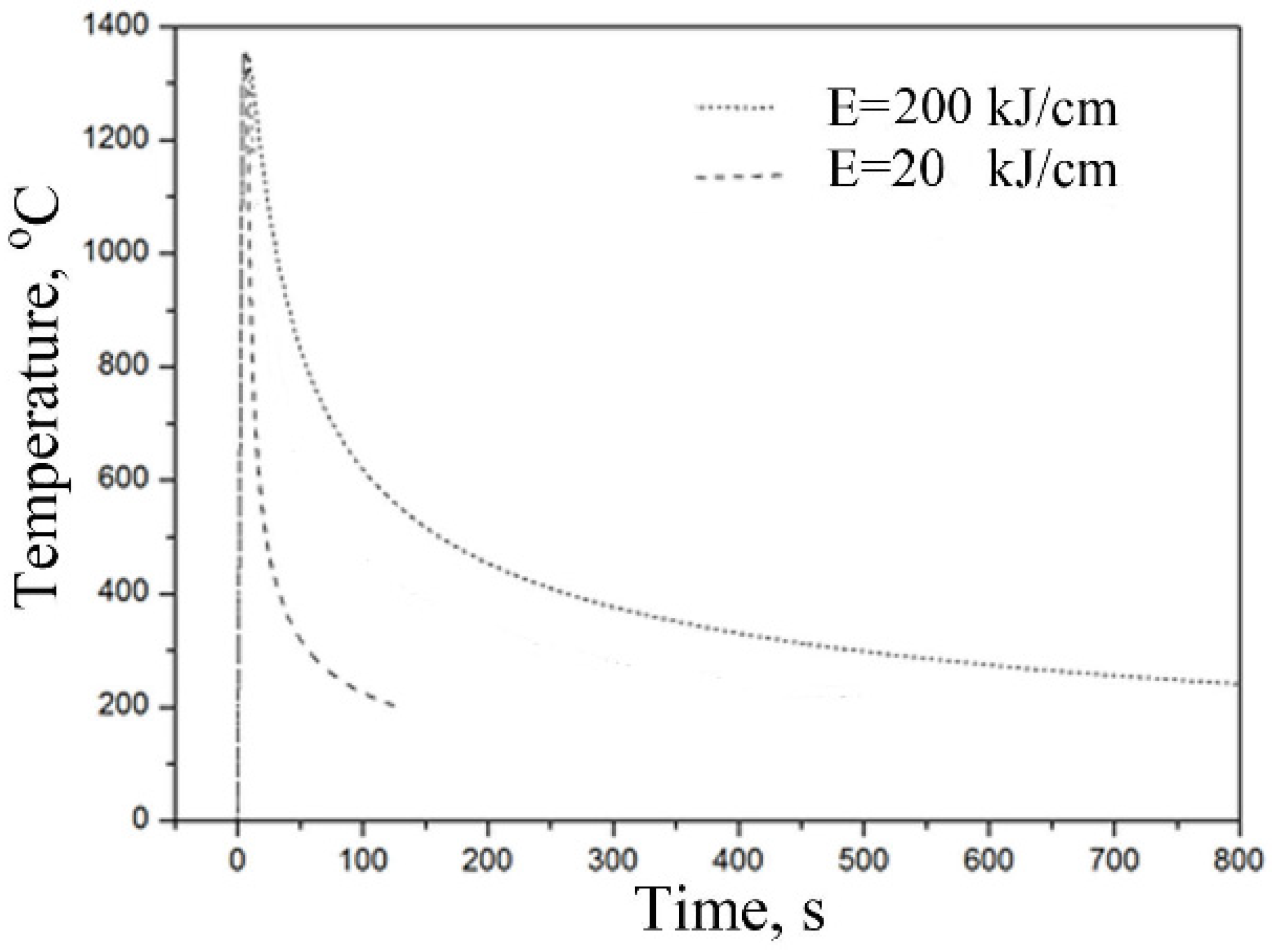
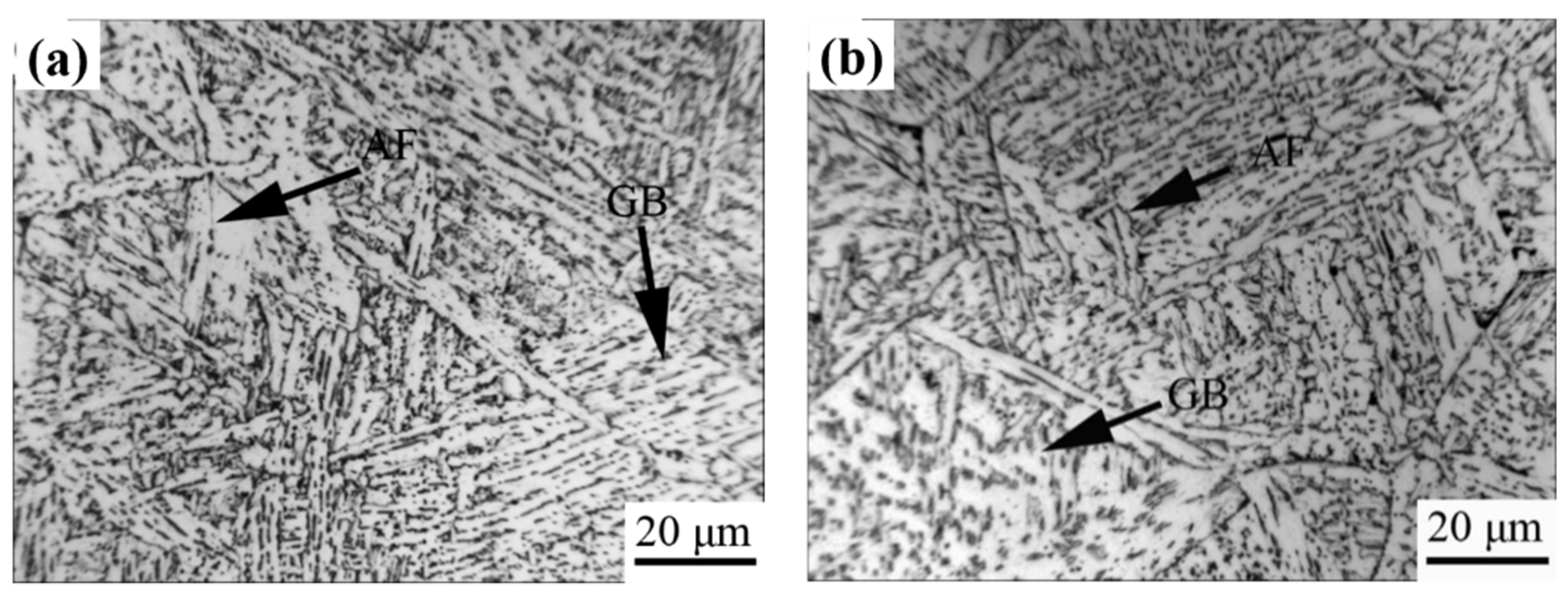

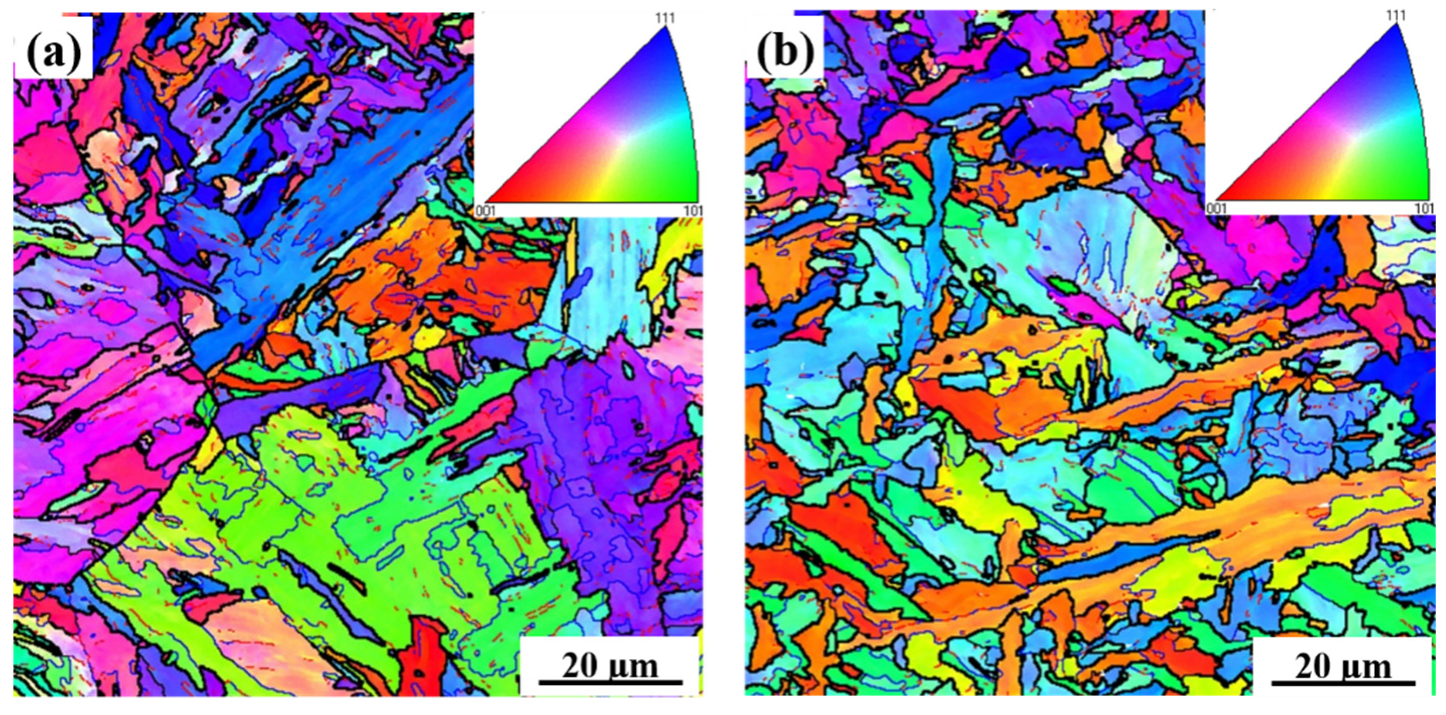

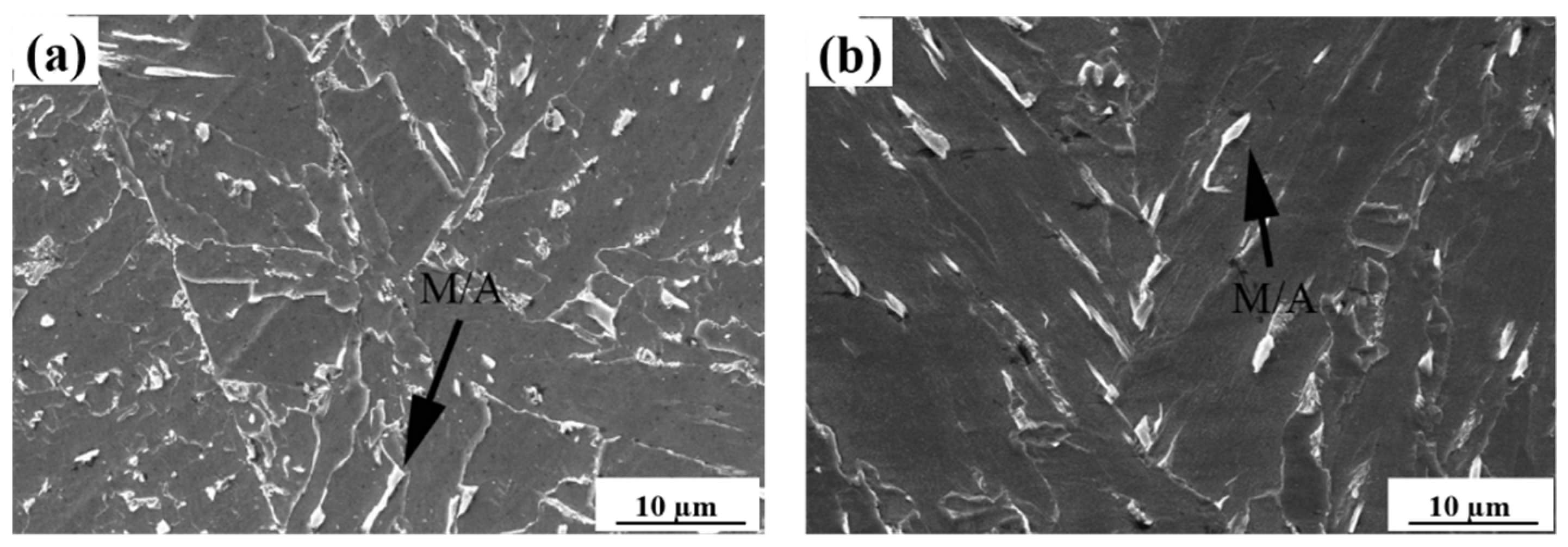
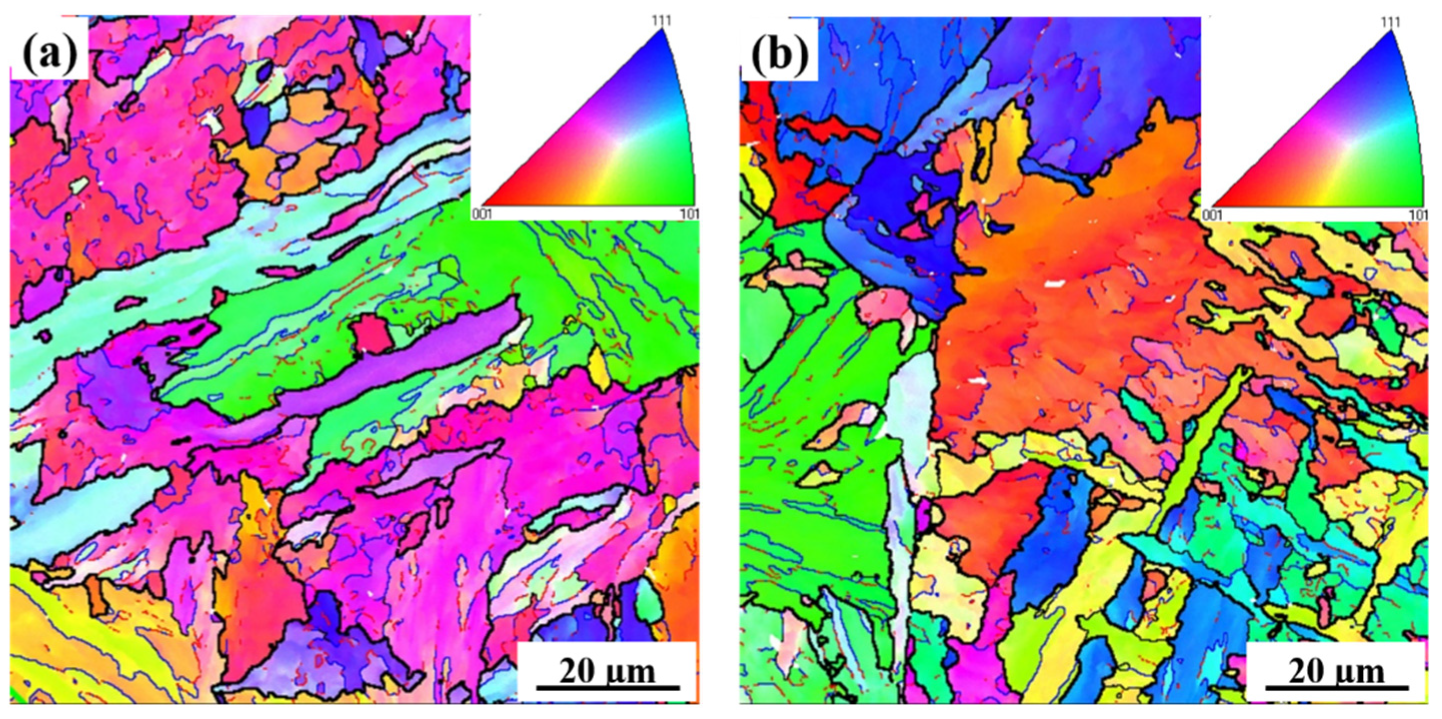
| No. | C | Mn | Si | V | Nb | Ti | Al | Fe |
|---|---|---|---|---|---|---|---|---|
| (a) | 0.062 | 1.55 | 0.20 | 0.021 | 0.073 | 0.027 | 0.013 | Balance |
| (b) | 0.052 | 1.62 | 0.21 | 0.022 | 0.110 | 0.020 | 0.012 | Balance |
| E | Rh | Tp | th | t8/5 |
|---|---|---|---|---|
| 20 kJ/cm | 300 °C/s | 1350 °C | 3 s | 10.6 s |
| 200 kJ/cm | 300 °C/s | 1350 °C | 3 s | 105.6 s |
| No. | Size of Austenite Grains (μm) | Size of Crystallographic Grains (µm) |
|---|---|---|
| (a) | 34.75 | 6.51 |
| (b) | 45.91 | 6.37 |
| Sample | <3° (%) | >5° (%) | >10° (%) | >15° (%) | >30° (%) | >40° (%) |
|---|---|---|---|---|---|---|
| (a) | 60.19 | 30.94 | 19.83 | 15.85 | 14.36 | 14.01 |
| (b) | 49.35 | 45.21 | 33.93 | 29.69 | 27.75 | 27.61 |
| No. | Size of Austenite Grain (μm) | Size of Crystallographic Grain (µm) |
|---|---|---|
| (a) | 91.17 | 11.51 |
| (b) | 98.13 | 8.30 |
| Sample | <3° (%) | >5° (%) | >10° (%) | >15° (%) | >30° (%) | >40° (%) |
|---|---|---|---|---|---|---|
| (a) | 56.60 | 35.17 | 18.70 | 15.11 | 13.91 | 13.75 |
| (b) | 57.06 | 35.40 | 22.53 | 18.20 | 15.72 | 15.36 |
| Heat Input kJ/cm | 0.073% Nb | 0.110% Nb | ||||
|---|---|---|---|---|---|---|
| Max | Min | Mean | Max | Min | Mean | |
| 20 | 87 | 64 | 79 | 200 | 162 | 182 |
| 200 | 62 | 19 | 43 | 11 | 8 | 10 |
Publisher’s Note: MDPI stays neutral with regard to jurisdictional claims in published maps and institutional affiliations. |
© 2022 by the authors. Licensee MDPI, Basel, Switzerland. This article is an open access article distributed under the terms and conditions of the Creative Commons Attribution (CC BY) license (https://creativecommons.org/licenses/by/4.0/).
Share and Cite
Yu, H.; Wu, K.; Dong, B.; Yu, L.; Liu, J.; Liu, Z.; Xiao, D.; Jing, X.; Liu, H. Effect of Niobium Content on the Microstructure and Mechanical Properties of Simulated Coarse-Grained Heat-Affected Zone (CGHAZ) of High-Strength Low-Alloy (HSLA) Steels. Materials 2022, 15, 3318. https://doi.org/10.3390/ma15093318
Yu H, Wu K, Dong B, Yu L, Liu J, Liu Z, Xiao D, Jing X, Liu H. Effect of Niobium Content on the Microstructure and Mechanical Properties of Simulated Coarse-Grained Heat-Affected Zone (CGHAZ) of High-Strength Low-Alloy (HSLA) Steels. Materials. 2022; 15(9):3318. https://doi.org/10.3390/ma15093318
Chicago/Turabian StyleYu, Hongwei, Kaiming Wu, Baoqi Dong, Liling Yu, Jingxi Liu, Zicheng Liu, Daheng Xiao, Xing Jing, and Hankun Liu. 2022. "Effect of Niobium Content on the Microstructure and Mechanical Properties of Simulated Coarse-Grained Heat-Affected Zone (CGHAZ) of High-Strength Low-Alloy (HSLA) Steels" Materials 15, no. 9: 3318. https://doi.org/10.3390/ma15093318
APA StyleYu, H., Wu, K., Dong, B., Yu, L., Liu, J., Liu, Z., Xiao, D., Jing, X., & Liu, H. (2022). Effect of Niobium Content on the Microstructure and Mechanical Properties of Simulated Coarse-Grained Heat-Affected Zone (CGHAZ) of High-Strength Low-Alloy (HSLA) Steels. Materials, 15(9), 3318. https://doi.org/10.3390/ma15093318






